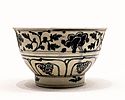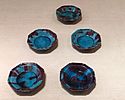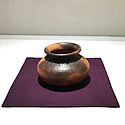Shimamono facts for kids
Shimamono (島物), which means "island objects," is a special name for Japanese tea utensils. These are items used in the traditional Japanese tea ceremony, but they were made outside of Japan, Korea, and China. Most shimamono came from countries in Southeast Asia.
History of Shimamono
Not all imported tea items are called shimamono. For example, items from Korea were known as kōraimono, and those from China were called karamono. These were considered different categories.
Shimamono items arrived in Japan on ships through busy trade routes. They became very popular in the 1400s and 1500s. The name "island objects" literally means they came from islands or places across the sea.
Later, during the time of a powerful Japanese leader called a Shōgun, named Tokugawa Yoshimune, Japanese craftspeople started making their own versions of shimamono. These Japanese-made items were sometimes called "striped objects" because of their patterns, but they still sounded like "shimamono" when spoken. These items are now considered part of Japanese pottery and porcelain.
Different Kinds of Shimamono
Many different types of shimamono were brought to Japan. Each kind had its own unique look and came from a specific place. Here are some of the most well-known types:
| Name | Kanji | Where it Came From | What Makes it Special | Example Image |
|---|---|---|---|---|
| Rusun ware | 呂宋焼 | Luzon (part of the Philippines) | These are pottery items. A famous merchant named Ruson Sukezaemon was very involved in trading Rusun ware in the 1500s. | |
| Annan ware | 安南焼 | Annam (Vietnam) | Often featured blue and white designs. They were originally used as rice bowls but became tea bowls in Japan. They have simple flower patterns and a tall base. A rare type, Beni Annan, is red and green. |  |
| Nanban ware | 南蛮焼 | Southeast Asia | This is a general name for items from Southeast Asia when their exact origin isn't known. |  |
| Amakawa | アマカワ | Macau | These items are made from white clay and have a grayish glaze. | |
| Mōru / Mo-ru | モウル / モール | Moluccas (Indonesia) | ||
| Tō Indu / Tenji | 東インドゥ | Eastern India | ||
| Kōchi ware | 交趾焼 | southern China | These items developed from a style called Cochin ware. They usually come in bright yellow, green, and blue colors. |  |
| Nekoro | ネコロ | Nicobar Islands (India) | ||
| Taiwan | 臺灣 | Taiwan | ||
| Hannera | ハンネラ | Southeast Asia | A simple type of pottery that isn't glazed. It often has a reddish or orange color. |  |
| Kinma | 蒟醤 | Siam or Burma | This is a type of lacquer ware. It has very detailed patterns that are inlaid into the surface. |  |
| Koma | 独楽 | Siam (Thailand) | Another type of lacquerware. It's called "spinning top" (koma) because the colors are painted in circles, like a spinning top. |  |
| Sahari | 砂張 | Southeast Asia | This is a general term for metal items. It's usually an alloy (mix of metals) made mostly of copper, with a little silver and lead, and often tin. These items were not originally made for tea ceremonies but became popular with tea masters. |

